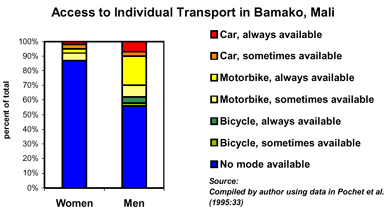|
GENDER AND TRANSPORT RESOURCE GUIDE
|
|
|
Module 1: Why Gender and Transport?
1.1. Transport TasksWomen and men are engaged in three basic types of transport tasks. Their involvement and related needs for these tasks are shaped by their gender roles and responsibilities. The specific nature of these tasks varies by country,socio-economic and ethnic group, location, and other factors.
Examples of Women's Transport Burden in Africa Gender disparities in transport responsibilities are particularly striking
in rural Sub-Saharan Africa. Much of rural Africa walks and carries
its burden, mainly on heads, shoulders and arms. And most of this burden
falls on women and girls.  Source: Gender and Transport in Less Developed Countries. D. Peters. 2001. p. 8.
Although men have limited access to transport in Bamako, Mali, women's access is much more limited, as shown by the large area of blue on the chart below. 
Source: Gender
and Transport in Less Developed Countries. D. Peters 2001.p. 13..
|
|
|
|
|
